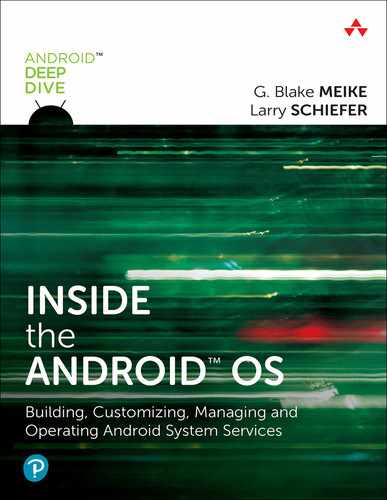Inside the Android OS is the first comprehensive guide and reference for developers who want to customize and integrate Android into their own embedded devices. Replete with code examples, it encourages you to create your own working code versions as you read -- whether for your own personal insight or for a workplace project in the fast-growing marketplace for non-phone Android devices. G. Blake Meike responds to the real-world needs of embedded and IoT developers moving to Android, providing indispensable information without becoming obscure or too specialized. Meike teaches through a book-length project that covers everything developers need to know to create their own custom Android service. You’ll find approachable yet precise coverage of: Why Android is becoming a pervasive embedded platform Using Android’s four-tier architectural model in embedded devices Setting up a build platform, downloading the AOSP source, and building an Android image Walking through system startup on a running Android system Running native services on embedded systems Using Android’s Native Development Kit (NDK) and HAL to link interpreted Java with native C/C++ code Taking a deep dive into the seminal Zygote application and its Dalvik interpreter Quickly building Java system services Working with Binder, Android’s heart and the root of its security and access control models Establishing permissions and access control Enabling apps to use the services you’ve created Building SDKs that allow third-party developers to code for your device And much more If you’re a software professional who wants to construct or maintain a successful Android-based product, this is the book you’ve been searching for.
Table of Contents
- Cover Page
- About This eBook
- Halftitle Page
- Title Page
- Copyright Page
- Dedication Page
- Contents at a Glance
- Contents
- Preface
- Acknowledgments
- About the Authors
- 1. Why Android?
- 2. Booting Acme
- 3. Getting Started
- 4. The Kernel
- 5. Platform Security
- 6. System Startup: Installing and Booting the System
- 7. Android Startup: Dalvik and Zygote
- 8. Getting to Android: The HAL
- 9. Getting to Java: The JNI
- 10. Project Treble: Binderized HAL
- 11. Creating a Custom Binderized HAL
- 12. Clients for a Custom Binderized HAL
- Index
- Code Snippets
